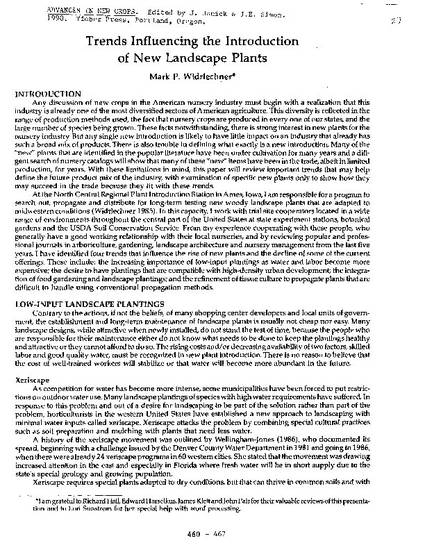
Article
Trends Influencing the Introduction of New Landscape Plants
Advances in new crops : proceedings of the First National Symposium NEW CROPS, Research, Development, Economics
Document Type
Conference Proceeding
Disciplines
Conference
First National Symposium on New Crops
Publication Version
Published Version
Publication Date
1-1-1990
Conference Title
First National Symposium on New Crops
Conference Date
October 23-26, 1988
Geolocation
(39.768403, -86.15806800000001)
Abstract
Any discussion of new crops in the American nursery industry must begin with a realization that this industry is already one of the most diversified sectors of American agriculture. This diversity is reflected in the range of production methods used, the fact that nursery crops are produced in every one of our states, and the large number of species being grown. These facts notwithstanding, there is strong interest in new plants for the nursery industry. But any single new introduction is likely to have little impact on an industry that already has such a broad mix of products. There is also trouble in defining what exactly is a new introduction. Many of the "new" plants that are identified in the popular literature have been under cultivation for many years and a diligent search of nursery catalogs will show that many of these "new" items have been in the trade,albeit in limited production, for years. With these limitations in mind, this paper will review important trends that may help define the future product mix of the industry, with examination of specific new plants only to show how they may succeed in the trade because they fit with these trends.
At the North Central Regional Plant Introduction Station in Ames,Iowa, I am responsible for a program to search out, propagate and distribute for long-term testing new woody landscape plants that are adapted to midwestern conditions (Widrlechner 1985). In this capacity, I work with trial site cooperators located in a wide range of environments throughout the central part of the United States at state experiment stations, botanical gardens and the USDA Soil Conservation Service. From my experience cooperating with these people, who generally have a good working relationship with their local nurseries, and by reviewing popular and professional journals in arboriculture, gardening, landscape architecture and nursery management from the last five years, I have identified four trends that influence the rise of new plants and the decline of some of the current offerings. These include: the increasing importance of low-input plantings as water and labor become more expensive; the desire to have plantings that are compatible with high-density urban development; the integration of food gardening and landscape plantings;and the refinement of tissue culture to propagate plants that are difficult to handle using conventional propagation methods.
Rights
Works produced by employees of the U.S. Government as part of their official duties are not copyrighted within the U.S. The content of this document is not copyrighted.
Language
en
File Format
application/pdf
Citation Information
Mark P. Widrlechner. "Trends Influencing the Introduction of New Landscape Plants" Indianapolis, IndianaAdvances in new crops : proceedings of the First National Symposium NEW CROPS, Research, Development, Economics (1990) p. 460 - 467 Available at: http://works.bepress.com/mark_widrlechner/133/

This is a proceeding from First National Symposium on New Crops (1990): 460.